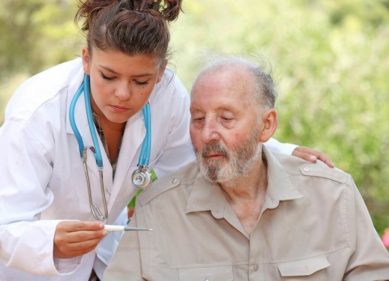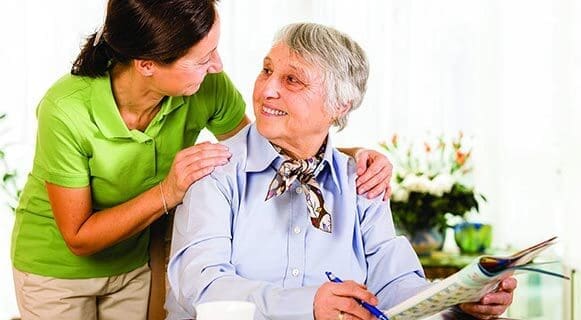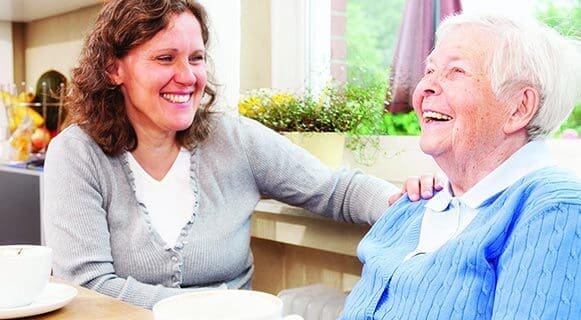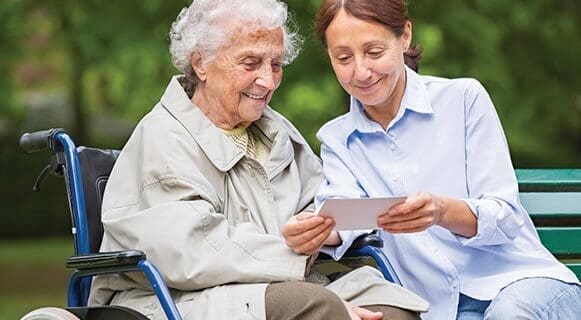Supporting those living with Parkinson’s at home
The majority of those living with Parkinson’s disease wish to stay in their own home and maintain their independence for as long as possible – which is where a specialist live-in carer can help.
A live-in carer can help someone living with Parkinson’s disease to remain in their own home and receive 24/7 care and support in a familiar environment that is safe, warm and comforting. A carer can help those living with Parkinson’s disease to maintain a good quality of life, with the reassurance that a trained and experienced carer is close by in times of need.
How Live-in Care Can Help with Parkinson’s Home Care
Live-in care offers a bespoke solution tailored to the unique needs of those living with Parkinson’s. The constant presence of a dedicated carer provides not only physical support but also emotional companionship, significantly enhancing the quality of life for individuals. Here are some of the ways live-in care can make a difference:
- Personalised Care Plans: Each care plan is tailored to the specific needs of the individual, ensuring they receive the right level of support for their condition. This includes assistance with daily activities, medication management, and mobility support.
- Enhanced Safety: With a carer present at all times, the risk of falls and accidents is greatly reduced. Carers can assist with movement around the house, provide support during activities, and ensure the home environment is safe.
- Nutritional Support: Proper nutrition is crucial for managing Parkinson’s symptoms. Carers can help with meal planning and preparation, ensuring that individuals receive balanced and nutritious meals tailored to their dietary needs.
- Emotional Wellbeing: The companionship provided by a live-in carer can greatly improve the emotional wellbeing of those with Parkinson’s. This constant support helps alleviate feelings of isolation and depression, which are common among individuals with chronic conditions.
- Rehabilitation and Exercise: Carers can assist with physical therapy exercises and other activities designed to improve mobility and strength, which are essential components of Parkinson’s home care.
- Respite for Family Members: Having a professional live-in carer allows family members to take necessary breaks, ensuring they do not become overwhelmed by their caregiving responsibilities.
Effective Techniques and Approaches for Parkinson’s Home Care
Providing effective home care for someone with Parkinson’s involves a multifaceted approach, incorporating various techniques and strategies to address both motor and non-motor symptoms. Here are some helpful tips and advice for managing Parkinson’s at home:
- Medication Management: Ensuring that medication is taken on time and in the correct dosage is critical. Carers can help by organising medication schedules, setting reminders, and monitoring for side effects.
- Physical Activity: Regular exercise can help improve balance, flexibility, and overall mobility. Activities such as walking, stretching, yoga, and specific Parkinson’s exercises recommended by physiotherapists can be beneficial.
- Speech and Communication: Speech therapy exercises can help maintain communication skills. Carers can assist by practising these exercises with the individual and encouraging regular conversation to keep these skills sharp.
- Occupational Therapy: Engaging in activities that enhance fine motor skills and daily functioning can be very helpful. This includes tasks like buttoning clothes, using utensils, and other daily activities that may require adaptive techniques.
- Diet and Hydration: A balanced diet rich in fibre, vitamins, and minerals is important. Carers can prepare meals that are easy to chew and swallow, and ensure adequate hydration throughout the day.
- Mental Health Support: Addressing non-motor symptoms such as anxiety and depression is crucial. Carers can provide emotional support, encourage participation in enjoyable activities, and facilitate social interactions to boost mental health.
- Home Environment Adjustments: Making the home environment safe and accessible is essential. This can include installing grab bars, ensuring good lighting, removing tripping hazards, and rearranging furniture for easier navigation.
- Relaxation Techniques: Techniques such as deep breathing exercises, meditation, and massage can help manage stress and improve overall wellbeing.
For additional resources and support, consider visiting the Parkinson’s UK website, which offers comprehensive information and guidance for those living with Parkinson’s disease and their caregivers.
What is Parkinson’s disease?
Parkinson’s disease affects certain nerve cells in the brain – specifically those that monitor a chemical called dopamine, which controls movement. When cells break down and those living with Parkinson’s disease are no longer receiving an adequate level of dopamine, they can find it difficult to move as much as they would wish to.
According to Parkinsons.org.uk, it’s thought that one in every 500 people in the UK has Parkinson’s. That equates to approximately 127,000 individuals, many of them over the age of 50, who require specialist care and support because of various mobility problems caused by the onset of the disease.
Some research has concluded that Parkinson’s is inherited to a degree, but it can also develop in those who have no family history of the condition. Read more to find out some of the signs and symptoms of Parkinson’s disease.
What are the signs of Parkinson’s disease?
Caring for someone with Parkinson’s disease can be difficult, so it’s important to be able to spot the signs. We’ve compiled some of the most common symptoms of Parkinson’s disease, as well as how they can affect a person’s body.
- Tremors: Involuntary shaking, often experienced in the hands, is the most common identifier of Parkinson’s disease. Resting tremors are very typical of Parkinson’s – these occur when the body is relaxed.
- Stiff muscles: As well as making it difficult to move fluidly, rigidity and inflexibility in the muscles can also lead to pain and cramps for those living with Parkinson’s disease.
- Slow movement: Those with Parkinson’s will often experience bradykinesia. They may only be able to walk by taking short, shuffling steps and may find that it takes them longer to do things than before.
- Problems with balance, mobility and walking: Those living with Parkinson’s disease are often unsteady on their feet. This can sometimes lead to accidents or injury through falling.
Other signs of Parkinson’s disease include:
- Loss of smell
- Health issues with the eyes and bladder
- Problems with communication and speech
- Difficulty swallowing and chewing
- Restless legs syndrome
- Excessive sweating
- Dizziness (making them more prone to falls)
- Fatigue
Individuals can also experience non-motor related symptoms such as pain, anxiety, depression, and in some cases, hallucinations and delusions.
Are you looking for Parkinson’s home care for a loved one? Call our friendly team on 0330 053 5014 today to discuss your requirements or to arrange a free care consultation.






